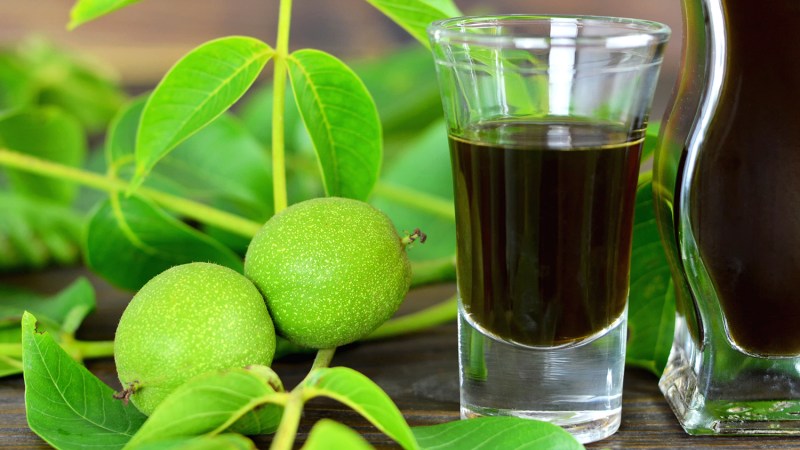
Like so many ancient drinks, the earliest uses of the Italian liqueur nocino were often medicinal. Users believed it helped with stomach issues and fended off the plague. In modern times, the liqueur, which is made from unripened walnuts that are harvested before the nut forms, is now used for enjoyment, especially in nocino liqueur cocktails.
Traditionally, nocino is made once a year, generally toward the end of June, when the walnuts are at just the right stage, though changes in climate have been pushing the harvest earlier, now sometimes to the middle of June, and if the harvest is smaller, there are fewer bottles of nocino made that year. Overall, though, you can still find the stuff in most specialty stores, and it’s a great base to play around with. There are even some domestic options, like this one from Ohio.
How should you enjoy this unique walnut liqueur? Start out having it neat after a big meal as a digestif. If you’re a mixed drink kind of person, try it out in classic whiskey cocktails like the iconic Manhattan or an Old Fashioned. It’s even great plugged into things like milk punch and coffee-centric cocktails. Play around — you’ll like what it can do, and a little bit can go a long way.
Jason Asher is a bartender with more than two decades of hospitality experience. The Phoenix native opened Century Grand in 2019, which houses a trio of bars under a single roof. The bartending veteran mixes with nocino now and again and loves how it works with certain spirits.
He said he first tried nocino about 20 years back, thinking it was a little weird and a bit reminiscent of a Pedro Ximenez sherry. “But the product that has been coming out in recent years is a lot more complex, and there is a lot more diversity in the category, with varying flavors and styles of Nocino,” he said.
For a liqueur built around a single ingredient, nocino is surprisingly versatile. “It plays well with everything, but it’s the modifier set—” i.e., what other ingredients are in the drink”— that is the key,” he told us. “In small amounts, it can play nicely with gin cocktails. It can be a refreshing and robust ingredient.”
So what in particular pairs well with the liqueur? “Cognac, bourbon, and rye also work really well with it,” Asher said. “Rye has a dill-like quality that nocino can work well with.”
Here are a few nocino liqueur recipes for intriguing new cocktails to try out.

JM’s Paradise Lost
This Manhattan-like drink is a thing of beauty and really takes advantage of nocino’s unique flavor profile. “For this drink, our goal was to extract the notes of oxidation from the process of drying the green walnuts,” Asher said. “Sotolin is the chemical/molecule (maple-like flavor) that you find in oxidized wines and fruit. The green walnut plays well with the banana and the funkiness of the Jamaican rum.”
Ingredients
- 2 ounces Worthy Park Jamaican Rum
- 1/4 ounce Carpano Dry Vermouth
- 1/4 ounce Carpano Antica Sweet Vermouth
- 1/4 ounce Vicario Nocino
- 1/8 ounce Giffard Créme de Banana
- 1/8 ounce M&R Select Bitter
- Orange peel
Method
- Stir all ingredients over ice in a cocktail glass.
- Squeeze the essence of orange peel over the glass and place in the drink.

Remy Martin no. 18
“This cocktail was inspired by an early morning walk in the woods while you’re hunting,” Asher told lus. “Think wet morning in the forest — you’d smell the dampness, the pine (burnt rosemary), and fresh air.” He added that the blueberry liqueur comes into play, as one would normally have wild game with wild berries.
Asher is reminded of gin when he thinks about green walnuts, as they’re both floral and earthy. “The nocino in this drink — we are using it in conjunction with really lightening ingredients. The vetiver root is similar to lemongrass, the lo-fi vermouth is light and refreshing, and the blueberry liquor is as well. Although it’s a cognac drink, it’s really refreshing and beautiful.”
Fear not if you lack these specific tinctures like most of us; you can still make a mean cocktail with the rest of the ingredients or similar substitutes. The in-house drink at Asher’s bar uses rosemary vape (hence the cloud above the drink), but you can get away with a close second at home without a vaporizer and rosemary oil.
Ingredients
- 1 1/2 ounces Remy 1738 Cognac
- 1/2 ounce Mirtillo Vergnano liqueur
- 1/2 ounce Pio Cesare Barolo Chinato
- 1/4 ounce Vicario Nocino
- 1/4 ounce Lo-Fi Dry Vermouth
- 1 dash rosemary tincture
- 1 dash vetiver root tincture
- 1 lemon peel
- Rosemary sprig for garnish
Method
- Stir all ingredients except cognac and strain into glass without ice.
- Add cognac, discard lemon peel, and garnish with rosemary sprig.

Ghost Story Cocktail
This amazingly named cocktail comes from the Watershed Distillery Kitchen and Bar, the Ohio-based maker of nocino. Try this for your next spooky campfire session, or just mix one up when you’re relaxing at home.
Ingredients
- 1 ounce bourbon
- 1 1/4 ounces nocino
- 1/4 ounce lemon juice
- 2 dashes of Angostura bitters
- Lemon peel for garnish
Method
- Add the bourbon, nocino, lemon juice, and Angostura bitters in a cocktail shaker with ice.
- Shake well.
- Strain the mixture iminto a rocks glass with ice (preferably one large ice cube).
- Twist the lemon peel over the drink to add the oil from the peel to the drink.
- Add the lemon peel to the glass as a garnish (optional).


